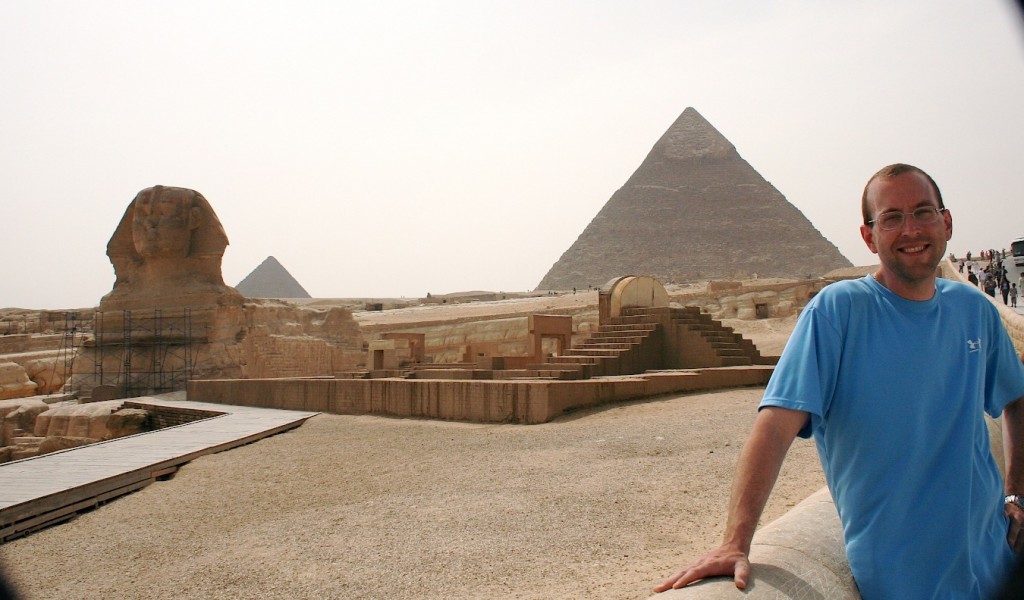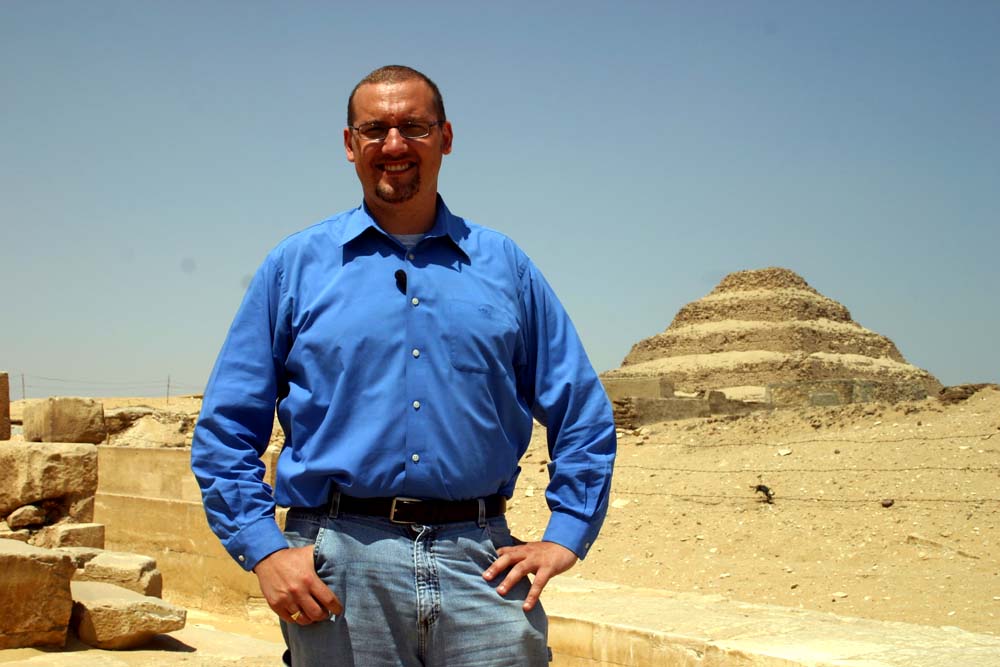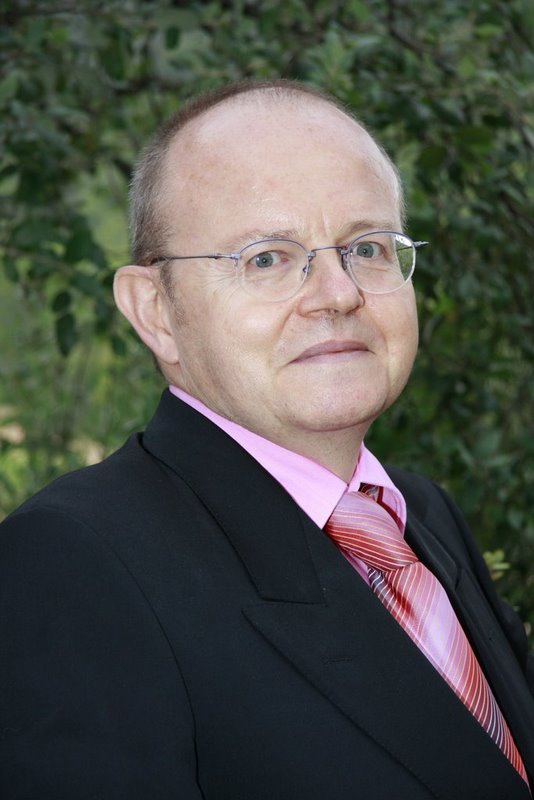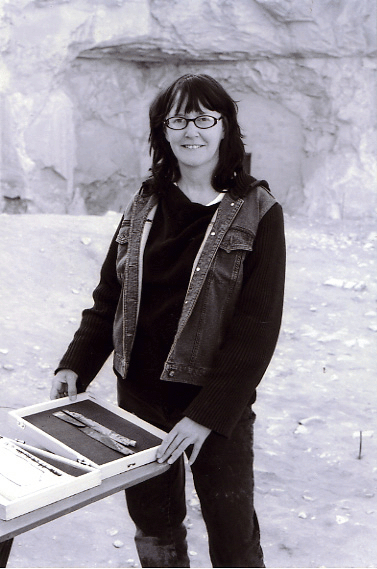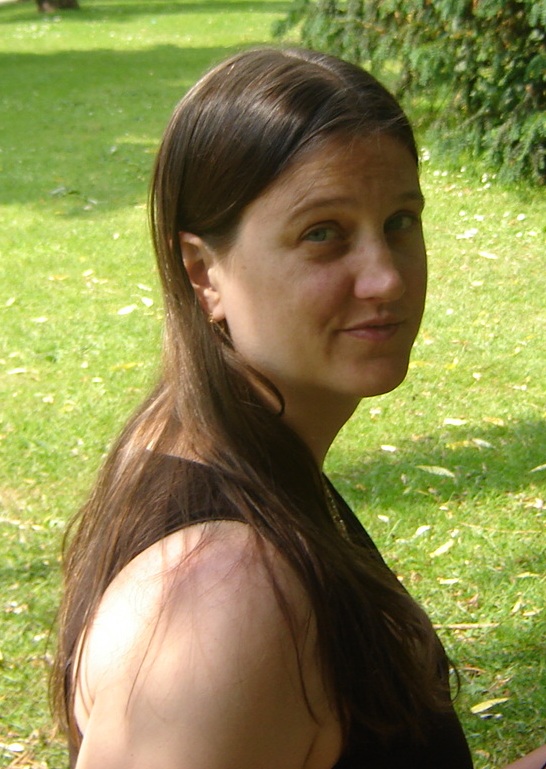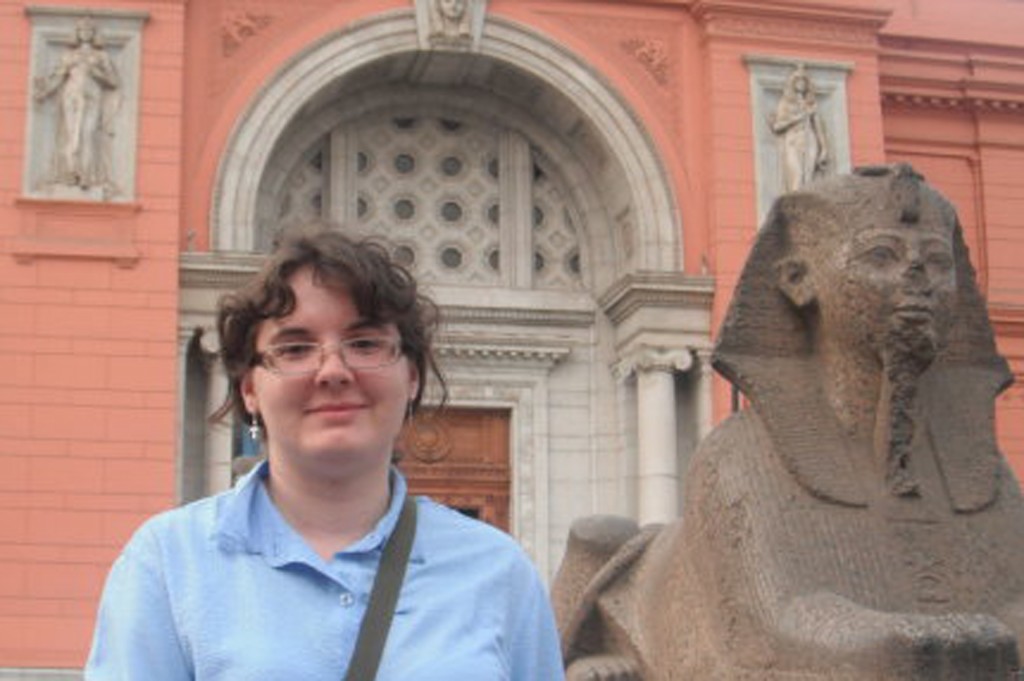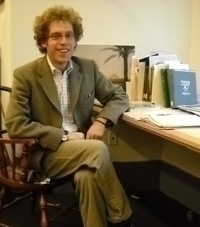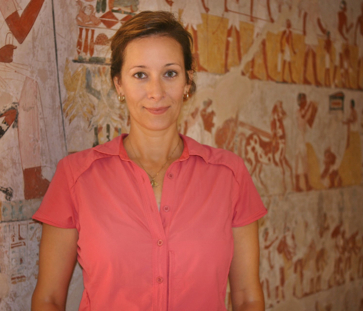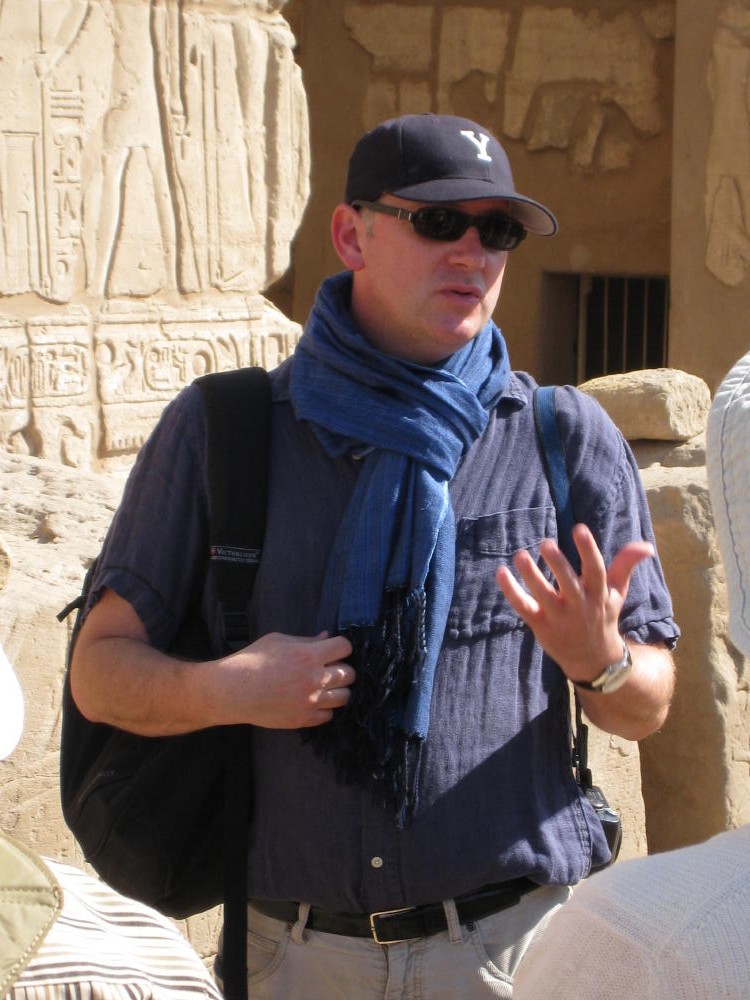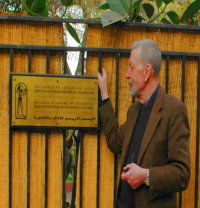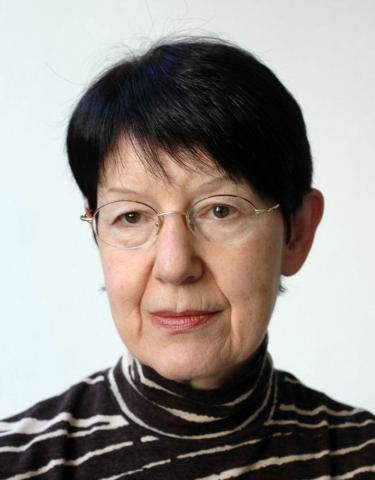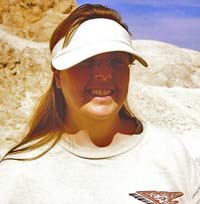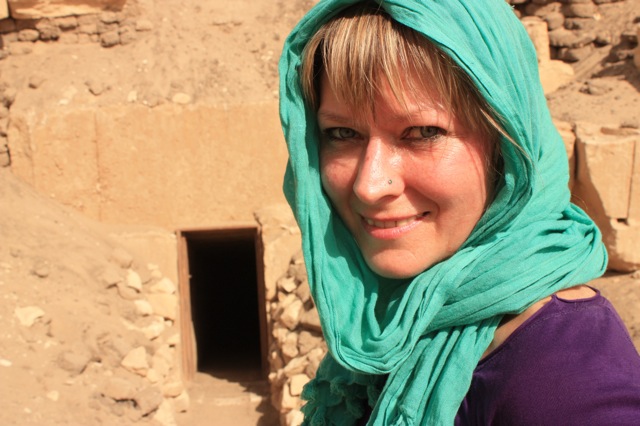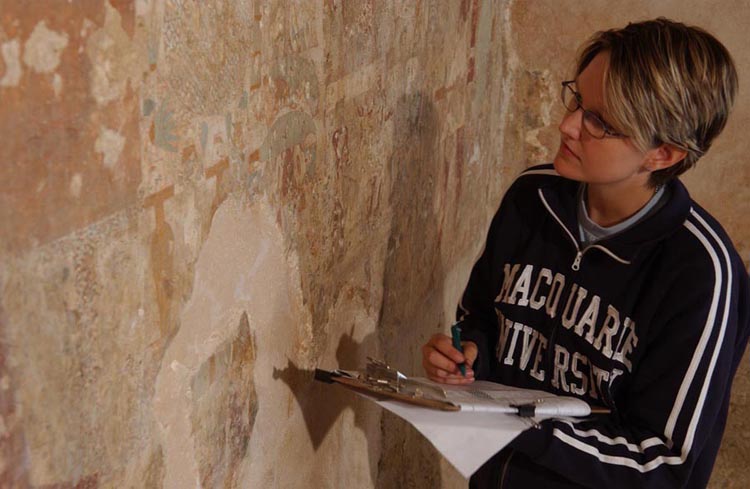Primary Team
Amy Calvert:
Amy Calvert is the founder and director of the Art of Counting project. This endeavor grew out of her Ph.D. dissertation project, The Integration of Quantitative and Qualitative Research in a Study of the Regalia of Ramses III, under direction of David O’Connor. Amy received her Ph.D. from the Institute of Fine Arts of New York University in May 2011. She received her M.A. in Egyptian Art and Archaeology at the IEAA of the University of Memphis in 2000, having studied the iconography of a royal Eighteenth dynasty chariot for her thesis. At Florida State University, where she received her B.A. in 1998, she studied Classical Archaeology, with a focus on Etruscan art, and Museum Studies. Working under Nancy de Grummond, Amy was among the few undergraduates selected to work on a graffiti-tracking project, which involved constructing a database to record the sigla and whose initial results were published by Brown University in 2000. She has been involved in several excavations in Italy, Egypt, and the U.S., and has acted as registrar in the field for the Osiris Temple Project at Abydos. In addition, Amy was awarded a semester-long internship at the British Museum and was Terrace Intern at the Egyptian Department of the Museum of Fine Arts, Boston, where she enjoyed a wonderful summer in the basement examining objects. She contributed an article–“Quantifying Regalia: A Contextual Study into the Variations and Significance of Egyptian Royal Costume Using Relational Databases and Advanced Statistical Analyses”–to Causing His Name to Live: Studies in Egyptian Epigraphy and History in Honor of William J. Murnane, edited by P. Brand and published in 2009. In 2013, her article on the symbolism of the New Kingdom royal chariot appeared in Chasing Chariots: Proceedings of the First International Chariot Conference, edited by André J. Veldmeijer & Salima Ikram.
Lili Garrard:
Lili Garrard holds an M.S. in Mathematics/Statistics from Michigan Technological University, with a focus on factor analysis, and a Ph.D. from the University of Kansas Medical Center. She was a Statistical Data Analyst at the National Database of Nursing Quality Indicators (NDNQI®), the only national nursing database that provides quarterly and annual reporting of structure, process, and outcome indicators to evaluate nursing care at the unit level. The University of Kansas Medical Center (KUMC) School of Nursing is contracted by the American Nurses Association (ANA) to manage the database. As a senior analyst, Ms. Garrard managed the production of RN Survey reports and conducts statistical analyses of the database to support publications and presentations for NDNQI researchers. Dr. Garrard is now a Mathematical Statistician with the FDA in Washington, D.C.
Craig Calvert, Director, Bekindr:
Craig Calvert is a professional psychometrician, writer, speaker, and neuroscience consultant. His academic background spans linguistics, computer science, TEFL (Teaching English as a Foreign Language), TESL (Teaching English as a Second Language), mathematics, international relations (with a focus on Rational Choice Theory and Social Identity Theory), and political science. He has been a business writer and ghostwriter since 1994, and worked in statistical research for a decade focusing on national healthcare databases. Published work includes advanced statistical insights taken from the databases of survey research conducted in acute care hospital environments, seeking to explain complex concepts in a language accessible to the general public. An extensive world-traveler, he has been to more than 30 countries on 3 continents. A hardcore geek and science nerd since he began programming in 1981 (at the age of 11), he is a neuroscientist, psychometrician, and a skilled database developer. Does crispy math for fun.
Professional Collaborators
Peter Brand:
Peter Brand received his Ph.D. in Ancient Egyptian Language and Literature from the University of Toronto in 1998. Since 2001, Dr. Brand has been an instructor at the University of Memphis, where he is now Dunavant Professor of Ancient History and Egyptology. He is also the Director of the Karnak Great Hypostyle Hall Project of the University of Memphis, which aims to record and publish all the monumental inscriptions and reliefs from this huge building. Dr. Brand is currently preparing a volume of translations and epigraphic commentary on over 350 scenes from the interior walls of the Great Hypostyle Hall, which will be published online and as a book. In collaboration with Dr. Jean Reves of the Université de Québec à Montréal and the Franco-Egyptian Center at Karnak, the Hypostyle Hall Project is also undertaking a record of the decoration on the 134 giant columns in the Hypostyle Hall.
Thierry Benderitter:
Thierry Benderitter, MD, is a board certified Anatomic Pathologist. Through his long medical career, Dr. Benderitter also graduated in dermatology, dermathopathology, immunology, and tropical medicine in addition to gaining a M.S. in biology. He served as the head of the Pathology Department at Toulon Hospital for several years before turning to private practice. Dr. Benderitter has been studying Egyptology informally for nearly 20 years and spent five years studying hieroglyphs at the Kheops Institute in Paris. For almost 10 years, Dr. Benderitter has been running OsirisNet, an invaluable online resource focused on ancient Egyptian tombs. Having recently retired from his medical practice, Dr. Benderitter is now happily devoting himself full-time to Egyptological pursuits. He is a member of the French Society of Egyptology and, having gained the support of multiple professional Egyptologists, was recently admitted in the International Association of Egyptologists.
Lorelei Corcoran:
Lorelei H. Corcoran (Ph.D., Near Eastern Languages and Civilizations, University of Chicago, 1988) is Professor of Art History and Director of the Institute of Egyptian Art & Archaeology at the University of Memphis. She is graduate advisor to the M.A. program in Art History with a concentration in Egyptian art and archaeology. Her research interests include: the iconography of the funerary arts of ancient Egypt, specializing in the Roman period; ancient Egyptian portraiture; the social context of imagery in ancient Egyptian culture; portrait mummies; and epigraphy. Her most recent monograph, Herakleides, A Portrait Mummy from Roman Egypt (J. Paul Getty Trust, 2010) with co-author, Marie Svoboda, associate conservator of the Antiquities Conservation Department at the J. Paul Getty Museum, is the result of a collaboration between the sciences and the humanities.
Denise Doxey:
Denise Doxey is Curator, Ancient Egyptian, Nubian and Near Eastern art at the Museum of Fine Arts, Boston. Before joining the staff of the MFA, she was Keeper of the Egyptian Section at the University of Pennsylvania Museum of Archaeology and Anthropology. She completed her B.A. at the State University of New York at Albany, her M.Phil at Oxford University and her Ph.D. at the University of Pennsylvania. She is the author or co-author of three books and numerous articles on various aspects of Egyptian art, archaeology and civilization. She has excavated in Greece and Egypt and has taught Egyptology courses at the University of Pennsylvania and Harvard University. Since coming to the MFA, she was the co-curator of The Secrets of Tomb 10A: Egypt 2000 BC and curator of recently opened galleries devoted to funerary arts of the Predynastic Period through Middle Kingdom.
Katherine Eaton:
Katherine Eaton is analyzing movement in ancient Egyptian temple offering rituals from three perspectives. Artistic depictions of ritual portray the king alone presenting a limited array of offerings using highly stylized postures and gestures. Texts reveal the presence of more offerings, actions and actors. Material remains reveal complexities in the physical apparatus of ritual performance – images, objects, architecture, etc. – which were simplified in both artistic and textual representations. This project is part of her broader interests in ritual performance in ancient Egyptian temple contexts, primarily of the early Ramesside Period. She received her Ph.D. from New York University in 2004 and has since published articles in prominent journals, including Zeitschrift für Ägyptische Sprache und Altertumskunde, Studien zur Altägyptischen Kultur and Journal of the American Research Center in Egypt. She is currently an honorary associate in the archaeology department at the University of Sydney and a member of the New York University Epigraphical Expedition to the Temple of Rameses II at Abydos, Egypt.
Rosa Erika Feleg:
Erika Feleg received her B.A. in History at the University of Bucharest, Romania and her M.A. from the IEAA at the University of Memphis in 2011, with the thesis “Features of the Early Relief Decoration of Ramesses II at the Karnak Hypostyle Hall and the Ramesside Forecourt at Luxor Temple.” She received her Ph.D. in 2016 and has long worked as a research assistant for Dr. Peter Brand. Erika regularly goes as part of Dr. Brand’s team to Karnak for research seasons, recording epigraphic and iconographic features of the scenes of Seti I and Ramesses II on the columns of the Hall.
Claire Gilmour:
Claire Gilmour’s Ph.D. research project critically assesses the properties of ancient Egyptian coffins, cartonnages, burial masks and other funerary equipment of the Third Intermediate Period to the Late Period. The main studies of this period have examined artefacts from the Theban area and this study compares and contrasts these with examples from elsewhere, analysing iconography, inscriptions, construction and materials to determine regional variations. Claire is a graduate of the University of Glasgow (M.A., Hons.) Archaeology/Celtic Civilisation, 2005) and the University of St Andrews (M.Litt, Museum & Gallery Studies, 2010), and a committee member of Egyptology Scotland and the Society of Museum Archaeologists. She is currently employed by the University of Glasgow Museum as a Collection Care Assistant.
Tom Hardwick:
Melinda Hartwig:
Melinda Hartwig is an Egyptologist who specializes in art history and archaeology. She received her Ph.D. from the Institute of Fine Arts at New York University in 2000. Melinda was an Associate Professor of Art History at Georgia State University (GSU) in Atlanta where she taught a wide range of lecture courses and seminars on ancient Egyptian, Nubian and Near Eastern art, archaeology and culture. She has also taught at the American University in Cairo, Egypt and the Institute of Egyptian Art & Archaeology, University of Memphis in Memphis, TN. She is now Curator of Egyptian, Nubian and Ancient Near Eastern Art at the Michael C. Carlos Museum at Emory University.
Stephen Harvey:
Since 1993, Stephen Harvey has been Director of the Ahmose and Tetisheri Project, which centers on excavation of the monumental complex of King Ahmose at Abydos, southern Egypt, under the aegis of the Pennsylvania-Yale-Institute of Fine Arts, NYU Expedition to Abydos. Dr. Harvey is currently an Adjunct Assistant Professor in the Department of History, Stony Brook University, and he divides his time between New York and London. He received his Ph.D. in Egyptian Archaeology in 1998 from the University of Pennsylvania, and his B.A. in Archaeological Studies from Yale University in 1987. Dr. Harvey’s fieldwork in and around the pyramid complex of Ahmose (ca 1550-1525 BC) has provided important new insight into temple architecture and decoration at the outset of Egypt’s New Kingdom. His book on the excavations to date is forthcoming from the Oriental Institute Press, University of Chicago. In addition to extensive fieldwork at Abydos, Harvey has worked in Egypt at Giza and Memphis, as well as on archaeological projects in the United States, Syria (Tell es-Sweyhat), and Turkey (Gordion). From 2003-2006, Dr. Harvey was Assistant Professor of Egyptian Archaeology in the Oriental Institute and the Department of Near Eastern Languages and Civilizations, The University of Chicago. In 2006, he led the reinstallation of the Picken Family Nubian Gallery of the Oriental Institute Museum, together with co-Curator Bruce Williams. From 1998 to 2002, Harvey was Assistant Director of the Institute of Egyptian Art & Archaeology and Assistant Professor in the Department of Art of the University of Memphis, TN. Dr. Harvey was Assistant Curator for Egyptian Art at the Walters Art Museum in Baltimore, Maryland from 1996 to 1998. He has been interviewed for a number of television documentaries, including “Egypt: Engineering an Empire” for the History Channel and “Egypt’s Golden Empire” for PBS, as well as for the introductory video for the major exhibition of objects from the Cairo Museum entitled “The Quest for Immortality.” He has been invited to lecture at many institutions in the US, as well as in Canada, England, Egypt, France, Australia, and New Zealand. Dr. Harvey has also been a popular lecturer on tours to Egypt sponsored by the Smithsonian Institution, the Field Museum, the Petrie Museum, and the Archaeological Institute of America.
Edward Loring:
Edward Loring was an Egyptologist with a special interest in the funerary art of the 21a Theban Dynasty of Payankh whose work in information technology greatly influenced the Art of Counting project. He sadly passed away on March 9, 2015. He had long been a Research Fellow at the Russian Academy of Sciences, Centre for Egyptological Studies, Moscow (CESRAS), and was co-founder of the Russian Institute of Egyptology in Cairo (RIEC). Extensive original photographic material made by CESRAS researchers can be seen at www.cesras.org. In conjunction with Dr. Maya Müller, he developed the The Databank of Eastern-European Egyptology, an example of an intelligent system, which allows not only the storage of information, but also the analysis of its contents. Loring developed the system architecture and logic, a further development of the post-relational system (performing recursions over selectively nested data-sets, in our case hierarchical thesauri) based on the well known complex entity relationship model. The system is an n-dimensional sparse matrix. Following the law of transitive systems, all transactions must take place though a centre. Any node of the matrix can function as the transitive centre of the entire system. The active central node shows what it “sees/knows” and those entities can show what they see and know in a cascade of levels. Any entity in such a construct can become the transitive centre of the system. As any entity or entity-relationship is actually only a number or set of numbers which can be indexed in several manners, all numbers are generated by the system and must never be altered.
Maya Müller:
Maya Müller is an Egyptologist and Art Historian who has specialised in the history of ancient Egyptian art for more than three decades. In the 1990s, when she was a Curator at the Basel Museum of Design and the ethnological museum (Museum of Cultures Basel) successively, she was engaged in introducing information technology, not only into the inventory and categorization of museum objects, but also into the documentation of Egyptian art in general. Her interest in databases lay on the level of data analysis, exclusively. Being a specialist in iconography, she developed an appropriate terminology for the description of objects, figures and scenes in a database. She paid particular attention to a logical classification and concise definition of terms, and to finding an equivalent English synonym to every German term, presenting results at the meetings of the international working group ‘Informatique et Egyptologie’. Dr. Mueller is now active in the international working group ‘Textiles of the Nile Valley’ (Late Antique, Byzantine, and Early Islamic iconography), researching also on themes from the MK, NK and the 1st Millennium, graphic arts, the realistic portrait, the creative process in art, and the history of Egyptological writing on art.
Michelle Marlar:
Michelle Marlar has a B.A. from Baylor University in Archaeology, an M.A. from the University of Memphis, Institute of Egyptian Art & Archaeology, and a second M.A. and a Ph.D. in Egyptian Art & Archaeology from the Institute of Fine Arts, New York University. She was a full-time faculty member in the Art Department at Morehouse College and has also taught as a part-time visiting lecturer in art history within the Ernest G. Welch School of Art and Design at Georgia State University. She is also the archaeological Field Director of the Osiris Temple Project in North Abydos, Egypt conducted under the aegis of the University of Pennsylvania Museum-Yale University-Institute of Fine Arts, New York University Expedition to Abydos.
Heather McCarthy:
Heather Lee McCarthy received her Ph.D. in 2011 from the Institute of Fine Arts at New York University and is Assistant Director of the New York University Epigraphical Expedition to the Temple of Ramesses II at Abydos. She is analyzing the iconography and regalia of Ramesside royal women. This project is related to her study of Ramesside royal women’s tombs in the Valley of the Queens and her dissertation, Queenship, Cosmography, and Regeneration: The Decorative Programs and Architecture of Ramesside Royal Women’s Tombs. She has published articles in, Journal of the American Research Center in Egypt, Journal of the Society for the Study of Egyptian Antiquities, Current Research in Egyptology 2005, Sex and Gender in Ancient Egypt, The Archaeology and Art of Ancient Egypt: Essays in Honor of David B. O’Connor, and Archaeology Odyssey.
Suzanne Onstine:
Within Egyptology, Suzanne Onstine‘s main areas of interest are women’s history and religion. Her book The Role of the Chantress in Ancient Egypt explores the intersection of these two subjects and reveals new insights into the political and social nature of women’s activities. Dr. Onstine’s approach to history is interdisciplinary, drawing on texts, art historical material, archaeology, and anthropological theory. This often leads her to research the material culture and social history of Egypt, focusing on the lives and pursuits of non-elite Egyptians. She is also very interested in the Nubian cultures that were contemporary with Ancient Egypt. In 2007, Dr. Onstine was awarded an ARCE fellowship to study the tomb of Panehsy, a man who held the unusual title of “overseer of the chanters of the offering table of Amun”. During her doctoral research she discovered very few men who were chanters – as opposed to the innumerable women who were chantresses in cult ceremonies. Dr. Onstine was therefore hopeful that an investigation of the largest monument of one such man would shed some light on the title and the duties associated with being a chanter/chantress. In two subsequent seasons she continued this research as a full scale epigraphic project, documenting the beautiful painted relief and the many inscriptions on the walls. Dr. Onstine was awarded a Faculty Research Grant for 2011 to fund some of the project’s excavations expenses and the project has subsequently unearthed and array of artifacts as well as hundreds of bones and mummy fragments.
Mani Saint-Victor, MD

Mani Saint-Victor, MD was born in Brooklyn and raised in Haiti before moving to Florida. He discovered BASIC on a PET machine in 4th grade. He became addicted to making video games, copying hundreds lines of code to watch a pixelated dot run around a maze of blocks and dots. Mani is a Harvard graduate, where he began experimenting with hacking his own brain and the science of mass interpersonal persuasion. Addicted to brains as a result of his work with Dr. Stephen Kosslyn, he decided that he would pursue computational neurochemistry. After graduating from the University of North Carolina School of Medicine, he immediately began pursuing his passions in the marriage of neurochemistry, persuasion, and game development. Using techniques gleaned from the edges of neuroscience, he built an enormous virtual community around the Unity development platform. Mani appeared in the Top 100 on Fast Company’s Most Influential People on the Internet.
Kasia Szpakowska:
Kasia Szpakowska is analyzing the formal characteristics of Late Bronze Age clay cobra figurines found in domestic, settlement, military, and administrative establishments in Egypt and the Levant. Shape, fabric, decoration, materials, contextual, geographical, and temporal patterns, associated finds, and breakages are all being considered to illuminate the figures’ use. These artifacts constitute a rare material manifestation of the religious practices of people less visible in the formal textual record: low-ranking workers, women, possibly children, and others on the fringe of society, who may have played an important role as agents in the transmission and development of religious practices in the Late Bronze Age. Since earning her Ph.D. from UCLA in 2000 she has published widely in journals and compilations. Her monographs and edited volumes reflect her interest in religion and daily life and include Behind Closed Eyes: Dreams and Nightmares in Ancient Egypt, Through a Glass Darkly: Magic, Dreams, and Prophecy in Ancient Egypt (editor), and Daily Life in Ancient Egypt: Recreating Lahun. A Phi Beta Kappa scholar Szpakowska has also been elected as a Fellow of the Society of Antiquaries. She is currently an Associate Professor of Egyptology at Swansea University, Wales.
Eric Wells:
Eric Wells received his Ph.D in Egyptology from the Department of Near Eastern Languages and Cultures, UCLA. He is now serving as Academic Counselor at UCLA’s Academic Advancement Program. Eric also manages an informative and engaging website with an active podcast schedule, posting gems on fascinating topics like MAGIC AND MASTURBATION: THE HELIOPOLITAN COSMOGONY, MAGIC AND MEDICINE IN ANCIENT EGYPT, RAPIST, THIEF, THUG: THE NOTORIOUS PANEB, and SEX, DRUGS, AND ROCK AND ROLL (Part 1 & 2).
Alexandra Woods:
Alexandra Woods is associate lecturer in the Department of Ancient History, Faculty of Arts, Macquarie University (Sydney), teaching Egyptology with a focus on art history and Old and Middle Kingdom studies. She was recently Visiting Professor at Emory University. Since 2003 Alexandra has been involved in archaeological fieldwork in Egypt at a number of sites including Saqqara, Deir el-Gebrawi, Meir and most recently Beni Hassan. She is currently participating in recording and studying the Teti cemetery and Ptahhotep complex at Saqqara as well as the tombs in the cemetery of Meir and Beni Hassan in Middle Egypt.
We are always seeking additional collaborators! This project will only improve with more involvement. If you are a data analyst or specialist in any period of art (graduate degree preferred, but not always required) and are interested in joining the Art of Counting team, please comment below.



